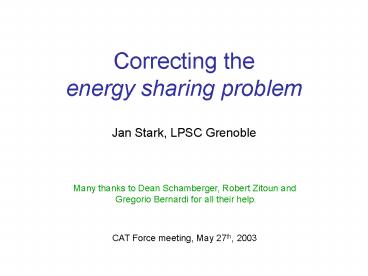Correcting the energy sharing problem - PowerPoint PPT Presentation
1 / 9
Title:
Correcting the energy sharing problem
Description:
BTW: these plots have been made using the thumbnail version of the correction. log scale ... Can be added to analysis executables that run in post-processing mode ... – PowerPoint PPT presentation
Number of Views:41
Avg rating:3.0/5.0
Title: Correcting the energy sharing problem
1
Correcting the energy sharing problem
- Jan Stark, LPSC Grenoble
Many thanks to Dean Schamberger, Robert Zitoun
and Gregorio Bernardi for all their help.
CAT Force meeting, May 27th, 2003
2
The energy sharing problem
- One of the BLS boards in a backplane was not
letting go of - the analog bus when it should.
- charge (energy) read from this particular board
is fine - for the other boards on the backplane we see the
average - of their own charge and the charge of the
bad board - Six bad boards in total (not all during exactly
the same time). - This means
- if charge in bad board (and no charge in the
other boards) - ? see seven more boards with half the energy of
the - bad board
- if charge in one of the other boards (and none
in the bad - board)
The worst bad boards affect data taken from
February to April.
Same event as above, but energy rather than
transverse energy is shown.
phi bin
eta bin
3
Strategy for the correction
- We know which boards were bad during which period
of time (which runs) - ? can invert charge averaging.
- To do this for a given event, we need to know the
raw number of ADC counts and the gain path - for each of the affected cells.
- This information is available in the RAW data
files. A good place to apply the correction is - therefore d0reco running over RAW data files.
- But reprocessing RAW data is a heavy burden. It
is desirable to have code that applies the - correction at DST or TMB level.
- Inconveniences of DST/TMB
- gain information is not available
- less information on very low energy cells than
in RAW files (offline zero-suppression) - finite precision on number of ADC counts due to
packing - Correction at DST/TMB level requires some
approximations - ? correction less accurate, but still possible.
4
A corrected event
Before correction
After correction
5
A corrected event (continued)
Different views of the same event (after
correction)
6
Another (more typical) event
Events where a bad board has a lot of energy look
spectacular, but are rare. More abundant are
events where one of the other boards has energy.
Tower energy (GeV) before correction
Tower energy (GeV) after correction
Tower energy difference before after
(GeV)
Note the different energy scales.
7
DST/TMB vs. RAW
Take 300 events from run 175054 and correct
the shared energy problem, once at RAW level and
once at TMB level. Compare the cell energies
obtained with the two different versions of the
correction. The plots on the right show the
difference cell energy after TMB correction
- cell energy after RAW correction for
all corrected cells.
log scale
outlier due to wrong guess of gain
GeV
zoom
- The effects of the inconveniences of DST/TMB can
be - seen in these plots
- gain information is not available (need to guess
gain) - leads to very rare outliers
- less information on very low energy cells than
- in RAW files (offline zero-suppression)
- dominant effect
- finite precision on ADC counts due to packing
- very small effect
either the cell itself, or its friend on the bad
board is killed by the offline zero suppression
GeV
8
Impact on missing ET
To estimate the impact of the shared energy
problem on missing ET, plot distribution of
missing ET for the first 51k events of run 175054
before and after the correction.
missing ET before correction
log scale
GeV
missing ET after correction
log scale
GeV
difference after - before
log scale
GeV
BTW these plots have been made using the
thumbnail version of the correction.
9
Conclusion
Implemented code to correct the shared energy
problem in data. Two versions of the code are
available - one that works on RAW
data Correction integrated into
d0reco. Available in CVS and included in the
latest build of p14.03 . - and one that works
on DST and TMB (thumbnails that include the
CalDataChunk) Correction implemented as
framework module. Can be added to analysis
executables that run in post-processing mode
(i.e. that re-reconstruct EM-candidates, jets,
etc. from the CalDataChunk). This code will be
committed to CVS today (requires some changes in
cal_nlc package). The correction at DST/TMB
level is less precise than the correction on RAW
data.































